You are troubleshooting the current issues caused by the application updates.
Which action can address the application updates issue without affecting the functionality of the application?
You need to recommend indexes for con-product and con-productVendor. The solution must meet the product catalog requirements and the business requirements.
Which type of index should you recommend for each container? To answer, select the appropriate options in the answer area.
NOTE: Each correct selection is worth one point.

You need to identify which connectivity mode to use when implementing App2. The solution must support the planned changes and meet the business requirements.
Which connectivity mode should you identify?
You need to select the capacity mode and scale configuration for account2 to support the planned changes and meet the business requirements. What should you select? To answer, select the appropriate options in the answer area. NOTE: Each correct selection is worth one point.

You need to select the partition key for con-iot1. The solution must meet the IoT telemetry requirements.
What should you select?
You configure multi-region writes for account1.
You need to ensure that App1 supports the new configuration for account1. The solution must meet the business requirements and the product catalog requirements.
What should you do?
You need to provide a solution for the Azure Functions notifications following updates to con-product. The solution must meet the business requirements and the product catalog requirements.
Which two actions should you perform? Each correct answer presents part of the solution.
NOTE:Each correct selection is worth one point.
You need to implement a solution to meet the product catalog requirements.
What should you do to implement the conflict resolution policy.
You are designing a data model for an Azure Cosmos DB for NoSQL account.
What are the partition limits for request units per second (RU/s) and storage? To answer, select the appropriate options in the answer area.
NOTE: Each correct selection is worth one point.
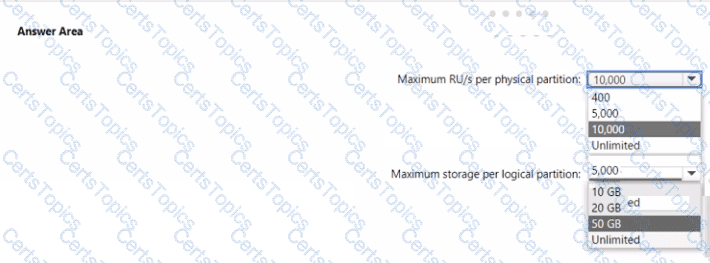
You have a multi-region Azure Cosmos DB account named account1 that has a default consistency level of strong.
You have an app named App1 that is configured to request a consistency level of session.
How will the read and write operations of App1 be handled? To answer, select the appropriate options in the answer area.
NOTE: Each correct selection is worth one point.

You have an Azure Cosmos DB container named container1.
You need to insert an item into contained. The solution must ensure that the item is deleted automatically after two hours.
How should you complete the item definition? To answer, select the appropriate options in the answer area.
NOTE: Each correct selection is worth one point.
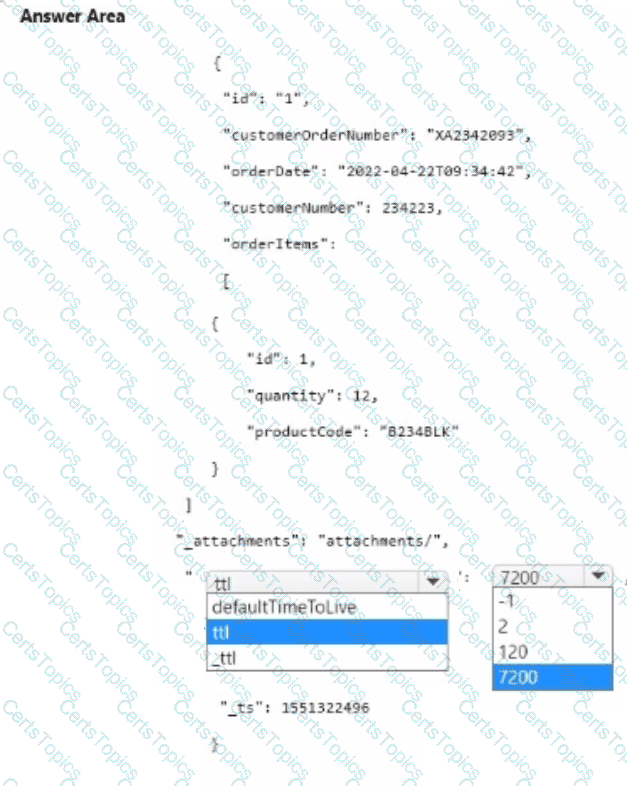
The following is a sample of a document in orders.
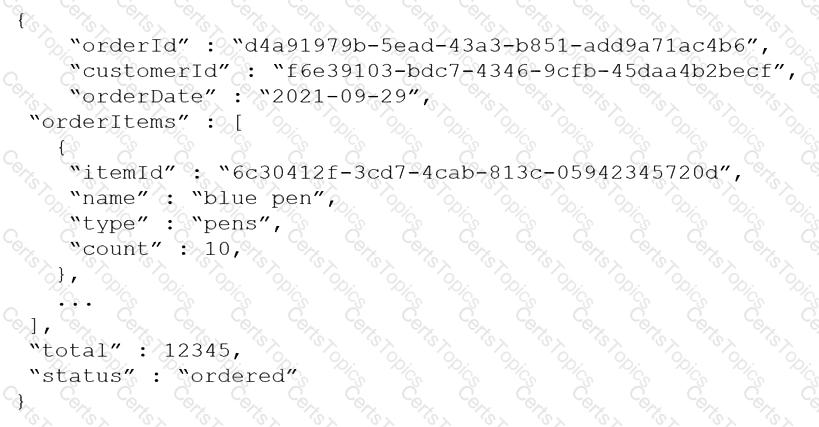
The orders container uses customer as the partition key.
You need to provide a report of the total items ordered per month by item type. The solution must meet the following requirements:
Ensure that the report can run as quickly as possible.
Minimize the consumption of request units (RUs).
What should you do?
You have an Azure Cosmos DB for NoSQL account. The account hosts a container that has the change feed enabled. You are building an app by using the Azure Cosmos DB SDK. The app will read items from the change feed by using a pull model. You need to ensure that multiple threads can read the change feed in parallel. What should you include?
You have a database named telemetry in an Azure Cosmos DB Core (SQL) API account that stores IoT data. The database contains two containers named readings and devices.
Documents in readings have the following structure.
id
deviceid
timestamp
ownerid
measures (array)
- type
- value
- metricid
Documents in devices have the following structure.
id
deviceid
owner
- ownerid
- emailaddress
- name
brand
model
For each of the following statements, select Yes if the statement is true. Otherwise, select No.
NOTE: Each correct selection is worth one point.

You have a database named db1 in an Azure Cosmos DB for NoSQL account named account1. The db1 database has a manual throughput of 4,000 request units per second (RU/s).
You need to move db1 from manual throughput to autoscale throughput by using the Azure CLI. The solution must provide a minimum of 4,000 RU/s and a maximum of 40,000 RU/s.
How should you complete the CLI statements? To answer, select the appropriate options in the answer area.
NOTE: Each correct selection is worth one point.

You have an Azure Cosmos DB database that hosts a container named container1.
You need to ensure that the items stored in contained will NOT expire unless their TTL value is set explicitly. What should you do?
You have a container in an Azure Cosmos DB for NoSQL account. The database that has a manual throughput of 30,000 request units per second (RU/s). The current consumption details are shewn in the following chart.
Normalized RU Consumption (%) By PartitionKeyRangeID


Use the drop-down menus to select the answer choice that answers each question based on the information presented in the graphic. NOTE: Each correct selection is worth one point.

You have an Azure Cosmos DB for NoSQL account that contains a container named container1.
You plan to use container1 as a key-value store that will perform point reads on the item ID and partition key.
You need to define an indexing policy for container! The solution must meet the following requirements:
• Provide the ability to set DefauitTimeToLive for container1.
• Minimize implementation time.
• Minimize costs.
How should you complete the JSON definition of the indexing policy? To answer, select the appropriate options in the answer area.
NOTE: Each correct selection is worth one point.
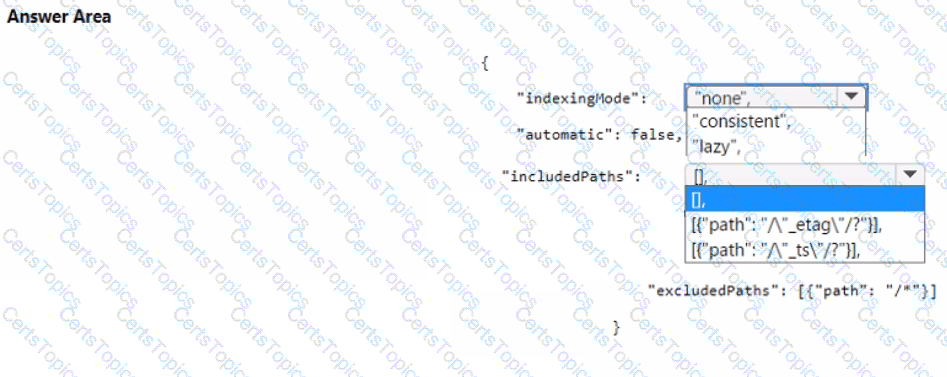
You have an app named App1 that uses an Azure Cosmos DB for NoSQL database.
App1 uses the spatial columns shown in the following table.

You need to design an indexing strategy for App1.
Which columns can be indexed by using spatial indexes?
You have an Azure Cosmos DB for NoSQL account.
You plan 10 create a container named container1. The container1 container will store items that include two properties named nm andage
The most commonly executed queries will query container1 for a specific name. The following is a sample of the query.

You need to define an opt-in Indexing policy for container1. The solution must meet the following requirements:
•Minimize the number of request units consumed by the queries.
•Ensure that the _etag property is excluded from indexing.
How should you define the indexing poky? To answer, select the appropriate options in the answer area. NOTE: Each correct selection Is worth one point.
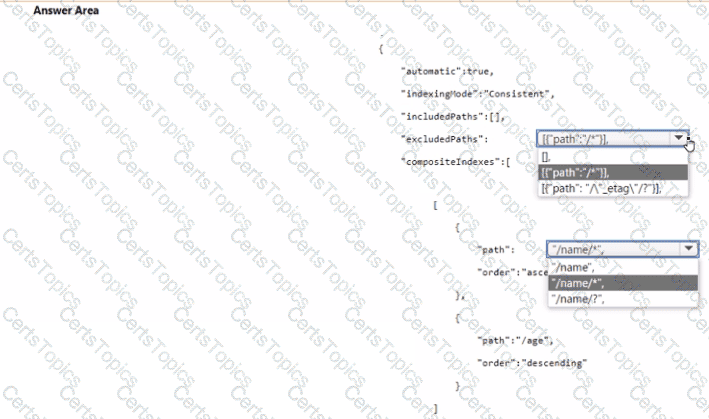
You have an Azure Synapse Analytics workspace named workspace1 that contains a server less SQL pool.
You have an Azure Table Storage account that stores operational data.
You need to replace the Table storage account with Azure Cosmos DB for NoSQL The solution must meet the following requirements:
•Support Queries from the server less SQL pool.
•Only pay for analytical compute when running queries.
•Ensure that analytical processes do
NOTE:affect operational processes.
Which three actions should you perform in sequence? To answer, move the appropriate actions from the list of actions to the answer area and arrange them in the correct order.

Note: This question is part of a series of questions that present the same scenario. Each question in the series contains a unique solution that might meet the stated goals. Some question sets might have more than one correct solution, while others might not have a correct solution.
After you answer a question in this section, you will NOT be able to return to it. As a result, these questions will not appear in the review screen.
You have an Azure Cosmos DB Core (SQL) API account named account 1 that uses autoscale throughput.
You need to run an Azure function when the normalized request units per second for a container in account1 exceeds a specific value.
Solution: You configure an application to use the change feed processor to read the change feed and you configure the application to trigger the function.
Does this meet the goal?